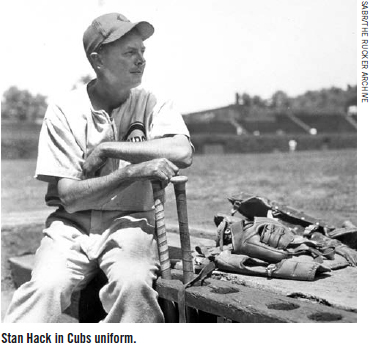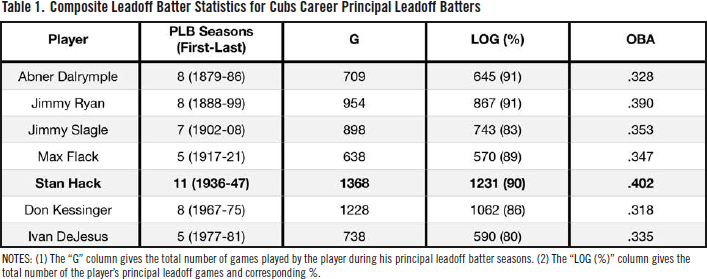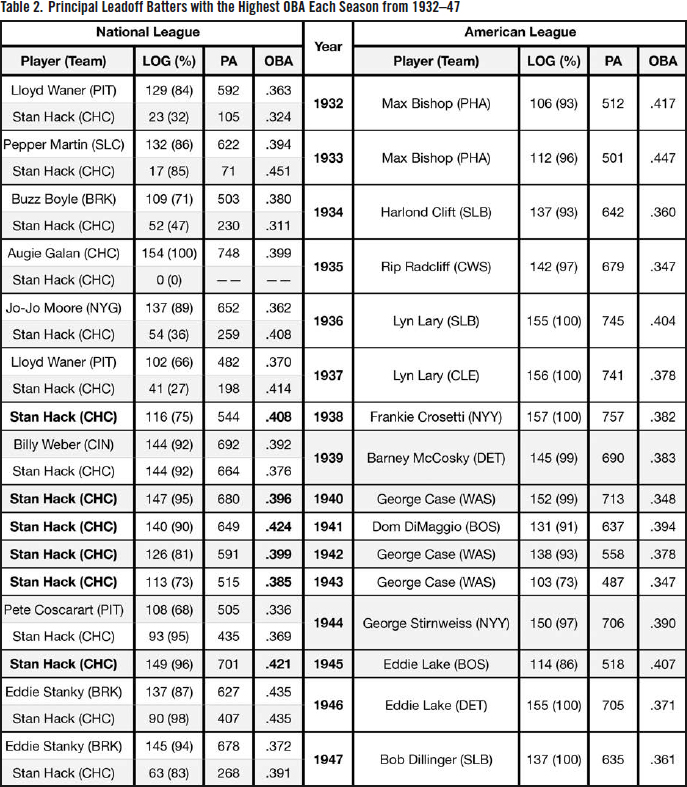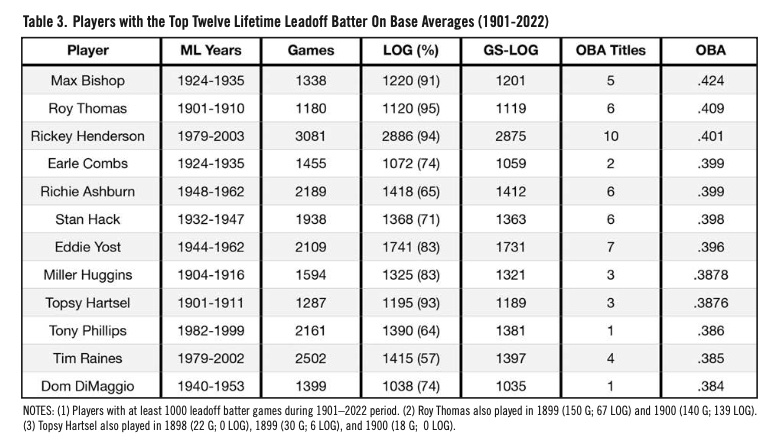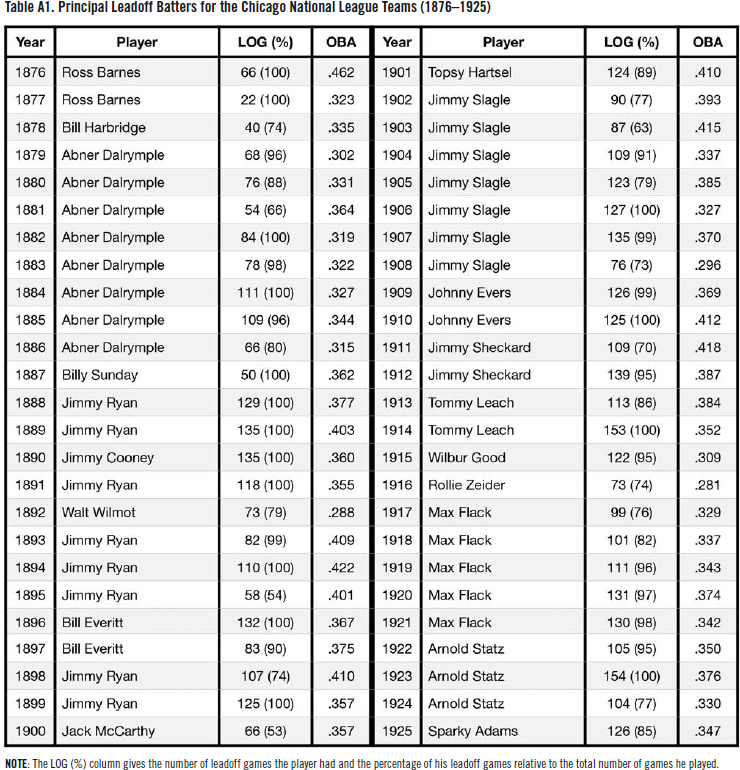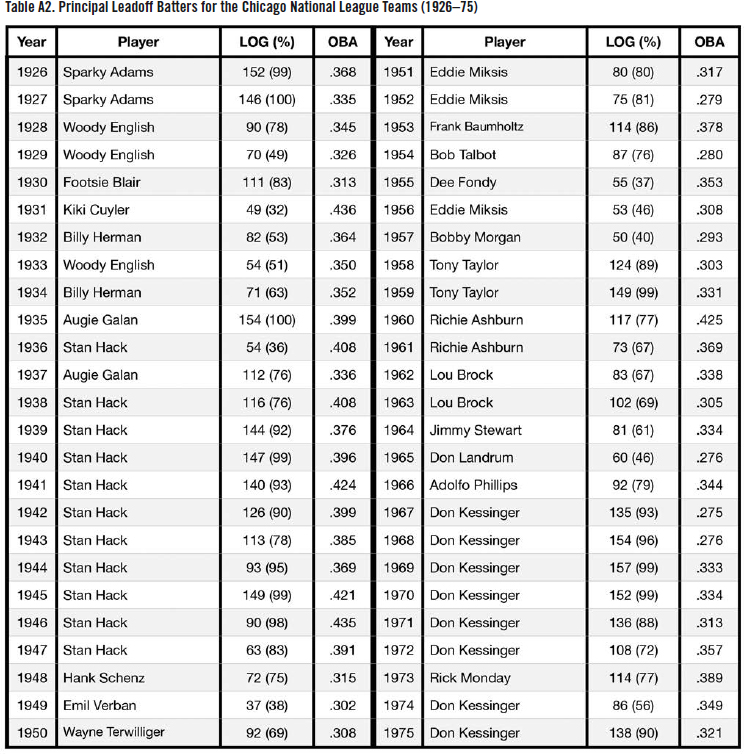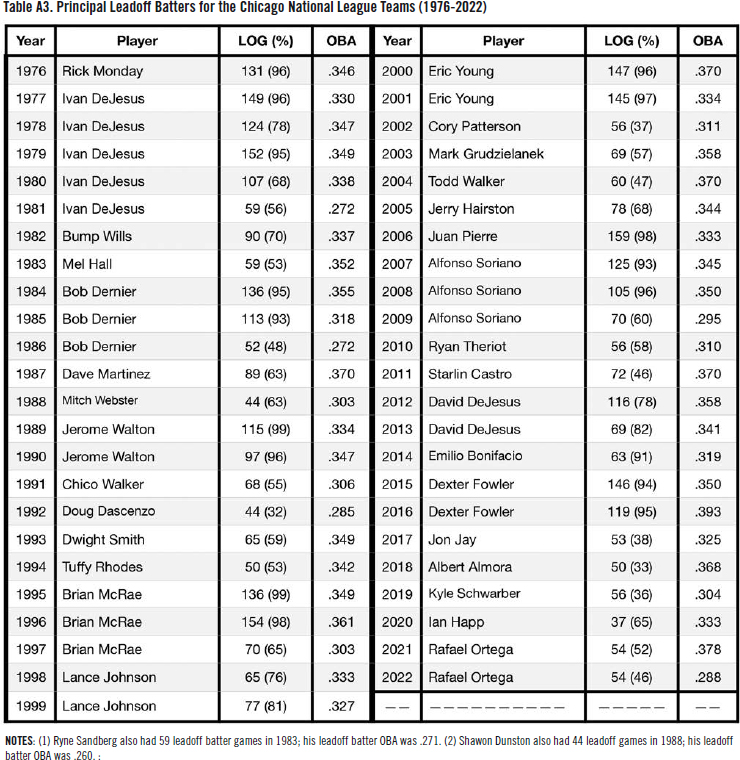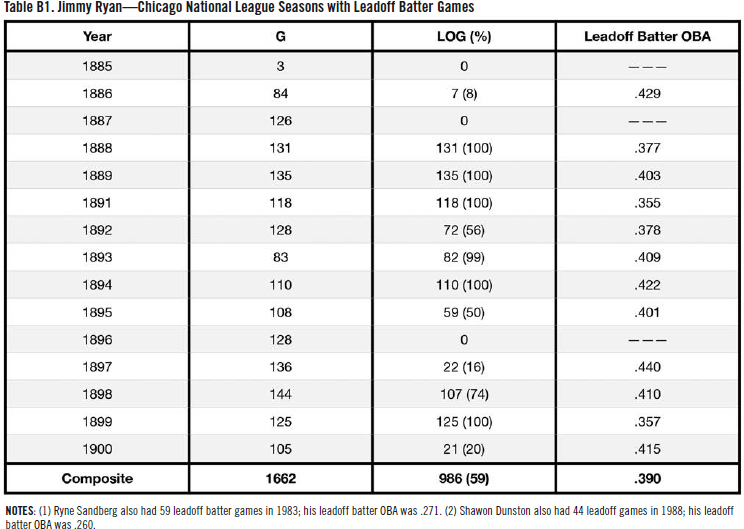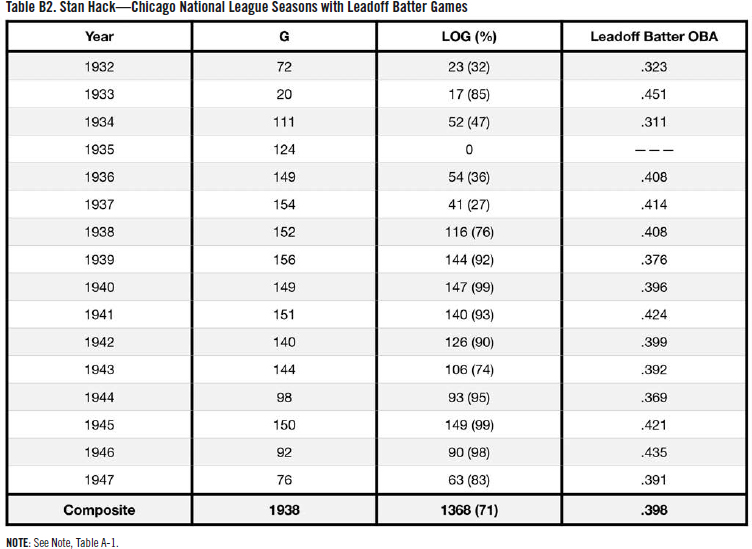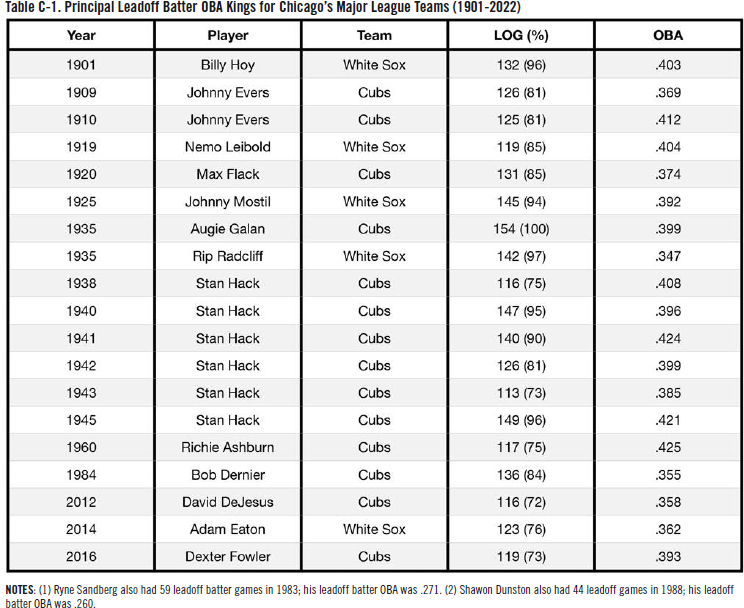Stan Hack: Leadoff Batter Extraordinaire
This article was written by Herm Krabbenhoft
This article was published in The National Pastime: Heart of the Midwest (2023)
Ross Barnes was the first principal leadoff batter (PLB) for the Chicago National League club. A PLB is defined as the player who is a team’s game-starting leadoff batter for the most games in a given season, and Barnes was at the top of the lineup for all 66 games Chicago played in the NL’s inaugural 1876 campaign. In the ensuing 146 years (through the 2022 season), 71 other players (including five Hall of Famers) have served as Chicago’s PLB in one or more seasons. Tables A1-3 (see Appendix on pages 83-85) provide a complete list of the PLBs for the Chicago NL club. Although the club was known by various nick- names—White Stockings (1876-89), Colts (1890-97), Orphans (1898-1901)—before officially becoming the Cubs in 1907, “Cubs” will be used throughout the article for simplicity’s sake.
Do any of the Cubs PLBs rank in the upper echelon of MLB’s career leadoff batters? To be regarded a career leadoff batter, a player must have been a PLB for at least five seasons. Inspection of Tables A1-3 reveals the following seven players were career leadoff batters with the Cubs:
- Abner Dalrymple (8 PLB seasons)
- Jimmy Ryan (8)
- Jimmy Slagle (7)
- Max Flack (5)
- Stan Hack (11)
- Don Kessinger (8)
- Ivan DeJesus (5)
With regard to evaluating leadoff batter performance, it is generally (if not universally) agreed that the primary responsibility of a leadoff batter is to get on base in order to “set the table” (create RBI opportunities) for the hitters in the heart of the batting order. Thus, the most practical metric for evaluating leadoff batter performance is On Base Average (OBA), defined as the number of times a player gets on base divided by his total number of plate appearances.1
Officially, there are three ways in which a batter can get on base safely: by getting a base hit, by drawing a base on balls, and by being hit by a pitched ball. Not included (officially) in getting on base safely are plays involving catcher’s interference, dropped third strikes, safe on fielder’s choices, and safe on fielding errors. Officially, total plate appearances include at bats, walks, times hit by pitches, and sacrifice flies (but not sacrifice bunts).
OBA = [H + W + HBP] / [AB + W + HBP + SF]
RESEARCH PROCEDURE
For the period from 1876 through 1900, the box scores provided in newspapers—principally The Chicago Tribune and The Inter Ocean—were used to identify Chicago’s game-starting leadoff batter for each game.
After determining the Cubs player with the most game-starting leadoff games, the box scores and game accounts were re-examined to obtain the player’s at bats, hits, and walks in his leadoff batter games. With regard to getting on base via being hit by pitched balls (which commenced in the NL in 1887), the requisite HBP numbers for the 1887-1900 PLBs were obtained from Pete Palmer’s detailed HBP list. The leadoff batter OBAs for the 1876-1900 PLBs were then calculated.
For the period from 1901 through 2022, the Stathead search engine on Baseball-Reference.com was employed to ascertain the number of leadoff batter games and the corresponding OBA for each Cubs player. The players with the most leadoff games in a given season (the PLBs) are listed in the Tables A1-3. Also included are the PLB’s OBA—i.e., his OBA exclusively in games in which he was the leadoff batter.
It is noted that the number of leadoff games shown includes games in which the player did not start the game but entered the game by replacing the player occupying the number-one position in the batting order. Typically, the number of non-starting leadoff batter games for PLBs is zero and usually no more than one or two games. For example, in 1989 Jerome Walton played in 115 games in which he batted leadoff; he was the game-starting leadoff batter in 114 of those games. In the game on May 7, Walton replaced game-starting leadoff batter, Dwight Smith, in the top of the seventh inning. Walton subsequently had one hit in one at bat, which are included in his leadoff batter statistics.
RESULTS
[A] Comparative Performance Among the Cubs Career PLBs
Table 1 presents the composite leadoff batter statistics for the aforementioned Dalrymple, Ryan, Slagle, Flack, Hack, Kessinger, and DeJesus. As can be seen, the Cubs principal leadoff batter who compiled the highest composite OBA—.402—is Stan Hack, who had the nickname Smiling Stan (see sidebar). Next in line is Jimmy Ryan, with a .390 OBA. The other five players listed in Table 1 assembled rather pedestrian OBAs— ranging from .353 down to .318. So, Stan Hack was found to be the Cubs best all-time PLB.
[B]. Comparative Performance Among Contemporary Major League PLBs
How well did Stan Hack perform as the Cubs PLB compared to his contemporaries? Table 2 provides relevant PLB OBA information for each season during Hack’s ML career (1932-47). For each season the PLB with the highest OBA is listed for both the NL and AL. In order to qualify for the symbolic PLB OBA title, the player must have had at least 477 plate appearances (PA) as a leadoff batter—i.e., 3.1 plate appearances per team scheduled game. This is the same requirement in Major League Baseball’s official rules for qualifying for a batting crown or OBA title.
For the first six years of his ML career (1932-37) Hack was a leadoff batter some of the time—23 games in his rookie season, 17 games the next year, followed by 52, zero, 54, and 41 leadoff batter games. His lead- off batter OBAs ranged from .311 to .451.
Beginning with the 1938 campaign, Smiling Stan was the PLB for the Cubs for ten consecutive seasons. Significantly, as shown in Table 2 (page 80), Hack won the symbolic leadoff batter OBA crown six times. It is also noted that in each of those six seasons his leadoff batter OBA was greater than that of the Junior Circuit’s leadoff batter OBA leader.
In 1938 Hack won his first symbolic leadoff batter OBA crown with a nifty .408, easily outdistancing runner-up Goody Rosen’s .376 leadoff batter OBA. However, Smiling Stan had a relatively off-year in 1939, producing a .376 leadoff batter OBA while Cincinnati’s Billy Werber manufactured a .392 leadoff batter OBA to take over the throne. In 1940, Hack responded with a more typical .396 leadoff batter OBA to regain the crown. (Runner-up Werber had a .371.)
Hack repeated as the leadoff batter OBA champion in 1941, turning in a lustrous .424 leadoff OBA. Hack then made it a three-peat in 1942 when his .399 leadoff batter OBA was 48 points higher than silver medalist Tommy Holmes’s .351. Hack’s leadoff OBA dropped to .385 in 1943, but was still 27 points higher than second- place finisher Danny Murtaugh’s .358.
So, in 1943, Hack had picked up his fifth overall and fourth consecutive leadoff batter OBA trophy. But, that appeared to be his last one. As described in Eric Hanauer’s SABR biography of Stan Hack, “Although Stan kept smiling, the losing was getting to him. At the end of 1943 he’d had enough. He didn’t get along with [Cubs manager Jimmy] Wilson, and retired at the age of 33. Wilson’s Cubs won their [1944] opener without Hack at third, but then lost 13 in a row. General manager Jim Gallagher fired Wilson, replacing him with Mr. Cub of that time, Charlie Grimm. One of the first things Grimm did was to call his old infield buddy and talk him out of retirement. Hack debuted on June 18. He was a bit rusty, played in only 98 games, and batted .282.”2 Hack was the Cubs leadoff batter in 93 of those games and put together a decent leadoff batter OBA of .369, a value which would have afforded him the trophy if he had played a dozen or so more games at leadoff. Pittsburgh’s Pete Coscarart was able to claim the 1944 trophy with a relatively low .336 mark. Hack was 42 plate appearances shy of qualifying for the symbolic crown.
DISCUSSION
Stan Hack played major league baseball for 16 years (1932-1947), entirely with the Chicago Cubs. He was their principal leadoff batter in eleven of those seasons (1936 and 1938-1947). With the requirement of 477 leadoff batter plate appearances, Smiling Stan captured the NL’s symbolic leadoff batter OBA throne six times—1938, 1940-1943, and 1945. That’s the most by any of the PLBs during the 1932-1947 period, five other players having achieved multiple leadoff batter OBA crowns: Max Bishop (2), Lloyd Waner (2), Lyn Lary (2), George Case (3), Eddie Lake (2), and Eddie Stanky (2). Expanding the period to the 1901-2022 seasons, there have been only nine players who were leadoff batter OBA kings in five or more seasons—Roy Thomas (6), George Burns (5), Bishop (6), Hack (6), Stanky (5), Eddie Yost (7), Richie Ashburn (6), Pete Rose (7), Rickey Henderson (10), and Ichiro Suzuki (5). From the perspective of composite leadoff batter OBA, during the 1901-2022 period there have been 55 players who accumulated one thousand or more career leadoff batter games. Stan Hack is one of those—altogether he was the Cubs leadoff batter in 1363 games. In those games he fabricated a composite .398 leadoff batter OBA, a figure which ranks number six in the top dozen of all-time—see Table 3.
Clearly, Smiling Stan Hack was a leadoff batter extraordinaire for the Chicago Cubs franchise and in the upper echelon of career leadoff batters for the entirety of Major League Baseball.
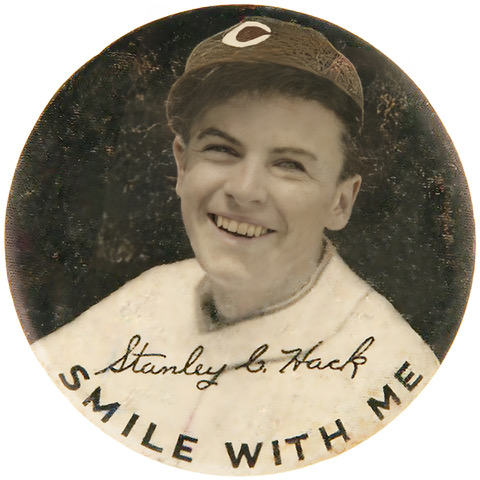
Reflecting on Smiling Stan
According to a 1932 newspaper article, Stan Hack had his “Smiling Stan” nickname before he began his major-league career with the Cubs. “In the Pacific Coast League, where young Mr. Hack was a star last year, his first season in professional baseball, he was known as ‘Smiling Stan.’ No matter how hard the coaches rode the rookie, Stanley would beam his contagious smile.”3
Sometime during Hack’s Cubs career (1932-47) souvenir pocket mirrors were produced by the Parisian Novelty Co. of Chicago. According to the description in a 2016 auction, the mirrors measured 2.25 inches in diameter. On the opposite side of the mirror was a black and white photo of Stan Hack with a facsimile autograph (Stanley C. Hack) and the slogan, “Smile With Me.” “The image is printed on fabric substance with a very fine texture.”4
In his autobiography, Bill Veeck wrote the following in Chapter 10 (“The Name of the Game is Gamesmanship”): “During my days with the Cubs, we had a great third baseman, Smiling Stan Hack. I well recall that in 1935, the sale of ‘Smile-with-Stan-Hack’ mirrors was exceptionally brisk to the bleacherites. Now that I think of it, it was rather strange how the makeup of female bleacherites seemed to need attention when the opposition was hitting.” Veeck’s tongue planted firmly in cheek, he continued, “And if a beam of light occasionally shone in the batter’s eye on a particularly important pitch…well, what better pitch to choose? Unladylike? Of course. Unsporting? Perhaps. Ineffective? Oh no. Awfully, awfully effective. And, until it happened too often perfectly legal.”5 This account also appeared verbatim in a newspaper article published three and a half months after his book came out.6
In a 1979 newspaper article the day after Stan Hack passed away, Bill Veeck was quoted as follows: “Right now I see Stan’s smile. It inspired one of my first zany ideas in baseball. I think it was the year after the 1932 World Series and I was determined to capitalize on Hack’s popularity and smile. I believe it was after we’d sent him to the minors for a short spell. Anyhow, I thought up the slogan ‘Smile With Stan Hack’ and had a concessionaire make some mirrors with a grinning picture of Stan on the back. They were sold, on target day, in the bleachers. We still [felt?] that fans should not only enjoy Stan’s smile, but they should take advantage of the sunshine and reflect the mirrors in the faces of the opposing batsmen. I believe we were playing Pittsburgh. Anyhow, the other team was furious. Umpires confiscated the mirrors, and threatened a forfeit if any more turned up. I’ve always hoped Stan saved one of those mirrors so he could occasionally look at it and enjoy his own smile, as so many of us did.”7
HERM KRABBENHOFT, a SABR member since 1981, is a retired research chemist. Among his numerous baseball research accomplishments are: Restoring the 1912 NL Triple Crown to Heinie Zimmerman; Establishing, in collaboration with Keith Carlson, David Newman, and Dixie Tourangeau, the accurate major-league record for most runs scored in a single season by an individual player—Billy Hamilton, 196 runs for Philadelphia in 1894; Determining the longest consecutive games on base safely streak in ML history—84 games by Ted Williams in 1949; Creating, in collaboration with Jim Smith and Steve Boren, the definitive SBK Triple Play Database. Herm is the author of Leadoff Batters published by McFarland in 2001. Krabbenhoft has been the recipient of three SABR Baseball Research Awards (1992, 1996, 2013).
Acknowledgments
I gratefully thank Pete Palmer for providing photocopies of the 1891-1900 ICI Day-By-Day sheets for Jimmy Ryan and detailed Hit-By-Pitch information for the 1887-1900 period. I also thank Larry Annis, Jack Bales, Cliff Blau, Bill Deane, Jim Drnek, Stanford Hack, Eric Hanauer, Ed Hartig, Richard Hershberger, Bill Hickman, Cassidy Lent, Gary Livacari, David McDonald, Alan Nathan, Dave Newman, Pete Palmer, John Racanelli, Jeff Robbins, Tom Shieber, Caleb Simonds, Richard Smiley, Cary Smith, Richard Stephens, Don Stokes, Gary Stone, Patrick Todgham, Mike Veeck, and Al Yellon for valuable help and/or discussions. And, I am grateful to Baseball-Reference.com and Retrosheet for their superb baseball- research-enabling websites.
Notes
1. Branch Rickey, “Goodby to Some Old Baseball Ideas,” Life, August 2, 1954, 78-89.
2. Eric Hanauer, “Stan Hack,” SABR BioProject (accessed December 12, 2022).
3. Edward Burns, “Hack, Cubs’ Rookie Infielder, Plucked Out of Bank on Coast,” Democrat and Chronicle (Rochester, NY), January 10, 1932, 27.
4. The winning bid was $370.98. “Stanley C. Hack/SMILE WITH ME” pocket mirror, Hake’s Auctions, hakes.com/Auction/ItemDetail/201987/STANLEY-C-HACKSMILE-WITH-ME-POCKET-MIRROR, March 15, 2016 (accessed December 18, 2022).
5. Bill Veeck and Ed Linn, Veeck as in Wreck, (New York: G.P. Putnam’s Sons, 1962), 158.
6. Bill Veeck, “Gamesmanship Helped Indians Win 1948 AL Pennant,” News-Journal (Mansfield, OH), September 14, 1962, 14.
7. David Condon, “Cub Fans, Smile if You Loved Stan Hack,” Chicago Tribune, December 16, 1979, 86.
(Click images to enlarge)



